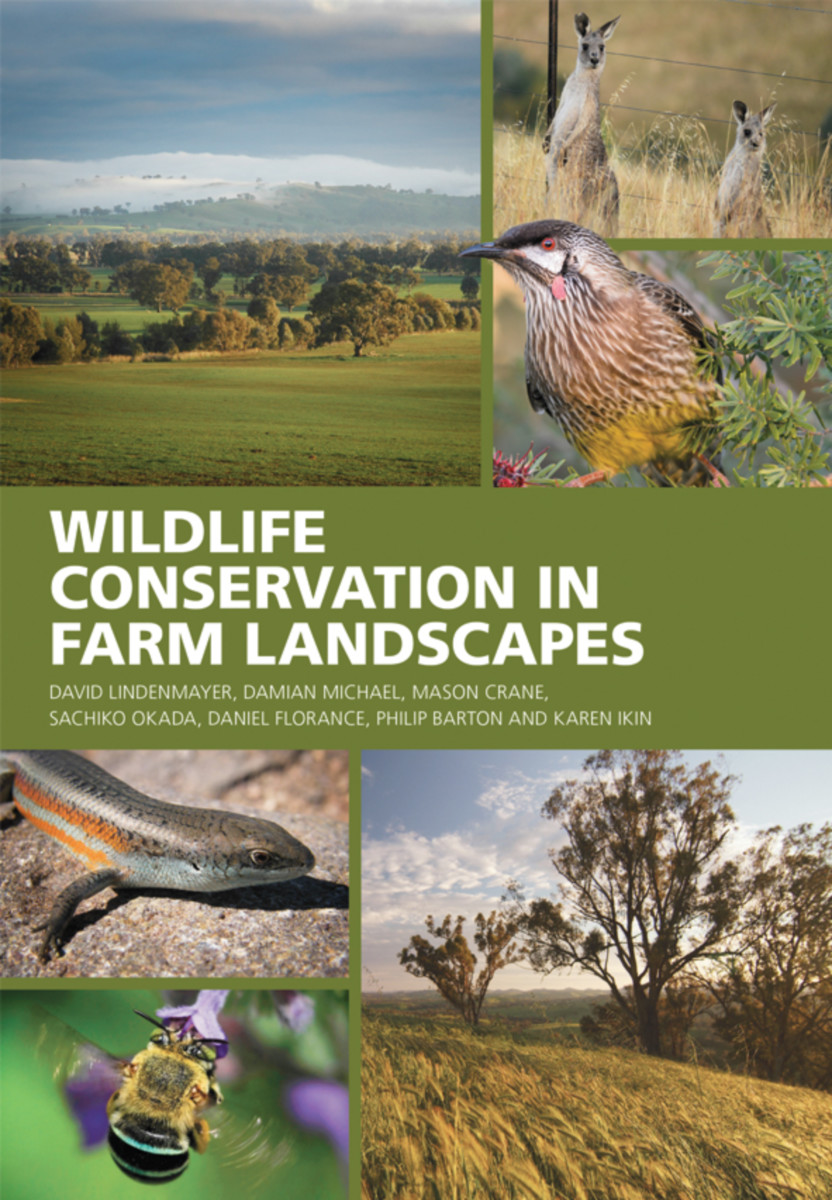EXCELLENCE IN SCIENCE PUBLISHING
Wildlife Conservation in Farm Landscapes
- Publisher
CSIRO Publishing - Published
27th March 2017 - ISBN 9781486303106
- Language English
- Pages 232 pp.
- Size 6.625" x 9.625"
- Images 164 color photos & 12 illus
An increasing number of Australians want to be assured that the food and fiber being produced there have been grown and harvested in an ecologically sustainable way. Ecologically sustainable farming conserves the array of species that are integral to key ecological processes such as pollination, seed dispersal, natural pest control and the decomposition of waste.
Wildlife Conservation in Farm Landscapes communicates new scientific information about best practice ways to integrate conservation and agriculture in the temperate eucalypt woodland belt of eastern Australia. Richly illustrated, with chapters on birds, mammals, reptiles, invertebrates and plants, this book illustrates how management interventions can promote nature conservation and what practices have the greatest benefit for biodiversity. Together the new insights in this book inform whole-of-farm planning.
FEATURES
* Spectacular images of restored and well-managed agricultural landscapes and the biota characteristic of these areas
* New information on the best ways to tackle issues associated with protecting areas of remnant vegetation, replanting/restoring native vegetation and the integration of conservation and agricultural production.
Preface
Acknowledgements
1 Introduction
The underlying philosophy of our applied research work and the scientific process
The concept of ‘scale’
The structure of this book
Our use of common and scientific names
Caveats
2 Birds
Bird breeding success in woodland patches
Birds in nest boxes
Birds and paddock trees
Networks of species – friends and foes
Not all patches of bush are equal - bird responses to different kinds of broad vegetation structure
Why are there such marked differences in bird occurrence between the different kinds of vegetation?
Which attributes of remnants are important for birds?
Which attributes of plantings are important for birds?
Birds and travelling stock reserves
Pines and woodland patches
Bird responses to total vegetation cover at different scales
Bird occurrence over time
Do plantings get better with age?
Birds and the Millennium Drought
Management interventions and birds
Are birds good indicators?
Concluding comments
3 Mammals
Introduction
Habitat trees, paddock trees and arboreal marsupials – the case of the Squirrel Glider
Countryside elements and mammals – the special case of the Squirrel Glider
Mammals in nest boxes
What makes a good woodland remnant for arboreal marsupials?
Mammals and travelling stock reserves
Can there be too many mouths to feed?
Change in mammal abundance over time
Mammals in woodland patches surrounded by pine stands
Concluding comments
4 Reptiles
A way of categorising reptiles
Reptiles and regrowth woodland
Do reptiles use tree plantings?
Boulenger’s Skink and lizard morphology
Rocky outcrops and reptiles
Management interventions and reptiles
Reptile assemblages
Reptiles in woodlands surrounded by stands of pine
Concluding comments
5 Invertebrates
Kangaroos and beetles
Ants in grazing landscapes
Butterflies in grazing landscapes
‘Bugs’ and pines – what happens to invertebrates in eucalypt patches surrounded by pine plantations
Concluding comments
6 Vegetation cover and plants
Introduction
Increase in vegetation cover over time
Changes in vegetation attributes over time
How management interventions changes and improves vegetation
Where in landscapes are key vegetation structures most likely to occur?
Paddock trees as keystone elements in agricultural landscapes – changes in paddock trees over time
Mistletoe as a key resource
Large logs as a critical resource
Home grown – native grass as a key habitat resource
Rocks are good for plants too
Regeneration dynamics in grazing landscapes
Where it is best to do plantings and how they should be designed?
Concluding comments
7 Managing wildlife friendly farms
Introduction
Protect what is already there
Restore what is missing
Putting it all together – evidence-based farm planning for integrating farming, biodiversity and other values
Developing evidence-based farm plans
Concluding comments
8 General discussion
Generating co-benefits – farming, carbon and wildlife
Being paid to conserve biodiversity on farms
The dangers of over-intensification
Fire and farm planning
Why monitoring is important
Concluding comments
Appendix 1 – List of common and scientific names
Appendix 2 – References
Index
David B. Lindenmayer
Professor David B. Lindenmayer AO has worked as a researcher on Australian farms for more than 23 years. He has a particular interest in improving environmental conditions on farm properties, including protecting remnant native vegetation as well as restoring and replanting it. He specializes in establishing and maintaining ecological large-scale, long-term research and monitoring programs on farms. He has co-authored a number of other books, including Natural Asset Farming and Restoring Farm Woodlands for Wildlife.
Damian Michael
Damian Michael is a Senior Research Officer in Ecology at The Australian National University. He has broad interests in landscape ecology, biodiversity conservation, herpetology and understanding the ecological importance of rocky outcrops in agricultural landscapes. He manages several large-scale biodiversity monitoring programs in New South Wales and has published 90 scientific papers and six books.
Mason Crane
Mason Crane has been a field-based research officer with the Fenner School of Environment and Society at the ANU for the last 15 years.
Sachiko Okada
Sachiko Okada is a senior research officer at the Fenner School of Environment and Society at the ANU.
Daniel Florance
Daniel Florance manages the Australian Government’s Environmental Stewardship Program. Since 2012, he has worked as a research officer at the Fenner School of Environment and Society at the ANU.
Philip Barton
Philip Barton is a community ecologist interested in the drivers of insect diversity in box-gum grassy woodlands.
Karen Ikin
Karen Ikin is a postdoctoral fellow with the ARC Centre of Excellence for Environmental Decisions, based at the Fenner School of Environment and Society at the ANU.


